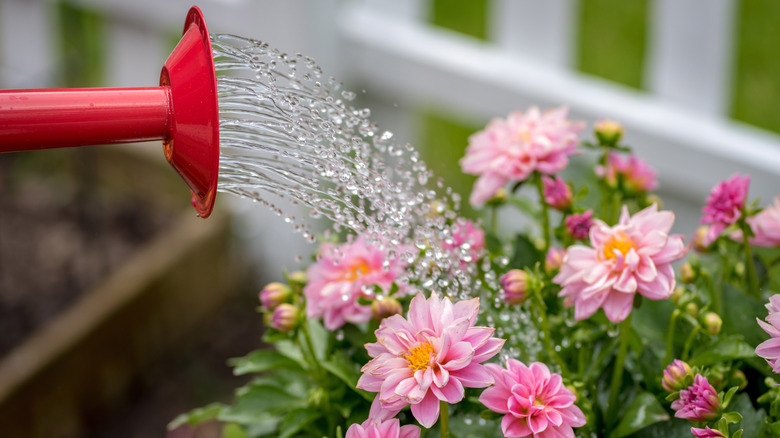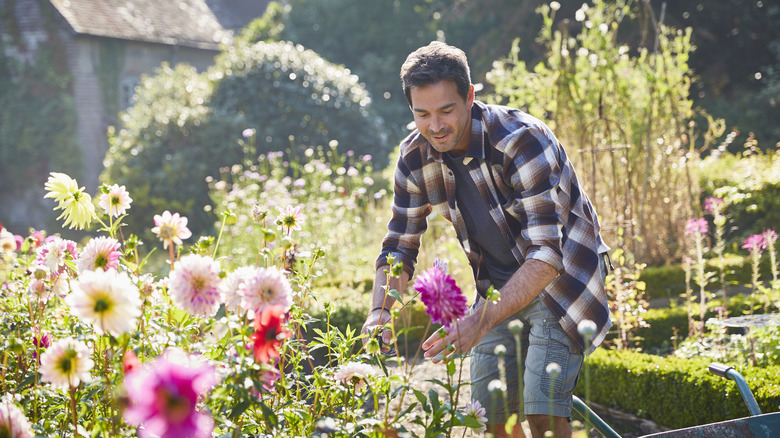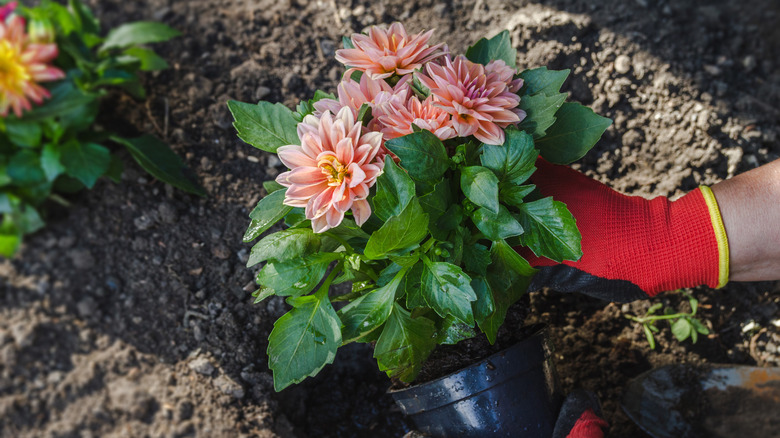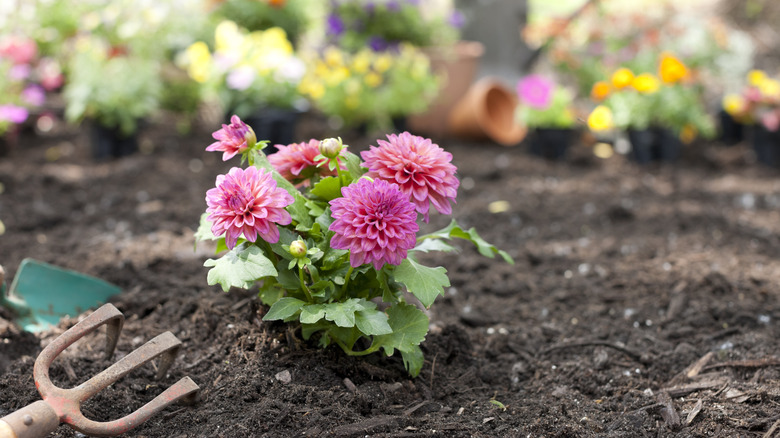There are some flowers that gardeners cannot help but love. The bright and welcoming dahlia is one of them. Available in a multitude of colors, sizes, and shapes, dahlias have been adored for their curled layered petals. These charming flowers can be grown in gardening zones 7 to 11. Though these flowers are beginner-friendly and, therefore, easy to grow, they can still fail to thrive. If you’re struggling to have your dream dahlia garden, you may be making one of five crucial mistakes.
It can feel discouraging when you plant a sea of flowers and see very little return. Luckily, dahlias are hardy and forgiving. So, it may take a simple adjustment to get your garden back on track. Considering what all plants need is the first step. Take note of the light, water, and soil quality your dahlias receive. A lack of any key nutrient can quickly become the reason your dahlias aren’t growing. These are all easy problems to fix if you know what to look out for.
You’re not watering enough

Flowers and other plants have a fickle relationship with water. Some flowers will withstand a lack of water, while others, like hydrangeas, are water-loving drama queens. Dahlias aren’t as temperamental as hydrangeas, but they do need a medium amount of water. Luckily, they can survive drought for a period of time, but eventually, their color and overall health will decline without a sufficient amount of hydration. You’ll need to examine the garden soil to determine if a lack of water is the reason for stunted growth.
Feel the top of the soil with a bare hand so you can assess it with your fingers. Dry, warm soil indicates that the water has already been absorbed by the soil or evaporated in the sun. If the top soil is dry, insert your index finger into the soil to feel any moisture further down. Should this still feel dry, your dahlia roots are not receiving enough water. Remedy this by watering your flowers in the morning before the sun is overhead and in the evening as the sun sets. Adjust watering as needed. You may find that dahlias in your zone require a third watering.
You planted the dahlias in a shady spot

Dahlias can tolerate low water levels for a bit, but they demand at least six to eight hours of sunlight per day. Your dahlias should be planted in direct sunlight, not in a shaded area. Though it may be tempting to put these delicate-looking flowers under a protective overhang, they can handle the elements. They thrive in them! Dahlias are warm-climate flowers, meaning they grow best in hot, humid weather with a lot of sunlight. However, dahlias should be planted in partial shade if you live in a region where the temperature is consistently over 100 degrees Fahrenheit. Dahlias tend to fade and stop growing in extreme heat.
Transporting and replanting flowers requires care, but it can be necessary. If you need to relocate your dahlias, use a gardening shovel and go slow until you confirm that you can safely remove the flower and all of its roots. It’s critical to leave the entire root intact so that the flower can absorb nutrients after replanting. Damaging the roots or leaving the ends of the roots in the soil can negatively impact the growing process and even prevent it from rooting in the new location.
You chose the wrong season to plant

Longfin Media/Shutterstock
Dahlias are native to Central and South America, so they like warm weather. Planting them when the soil is cold won’t yield any results. These flowers will not grow or bloom until the soil is at least 60 degrees Fahrenheit. So, if you planted your flowers early in the year or late in the year, soil temperature could be the reason your dahlias have failed to thrive. Use a soil thermometer to check the temperature of the ground to confirm that your plants are warm enough to grow. You should consider removing the bulbs if you anticipate heavy rainfall. Too much water at an early, inactive stage can lead to rotting tubers.
The best time to plant dahlias is in the spring after the last frost. Planting flowers that have been started indoors is a great way to immediately enjoy a garden of dahlias. To start the growth inside, plant tubers in well-draining growing pots. Leave the starter flowers near a window that gets plenty of sunlight. Water them enough to moisten the soil, but do not overwater. Once the temperature is right and the frost has stopped, transfer the dahlias outside.
You’re not supporting them
knelson20/Shutterstock
Dahlias come in multiple sizes, but many of them grow nearly 5 feet in height. Any plant or flower that grows this tall is bound to have some trouble staying upright. Staking flowers, especially top-heavy perennials like dahlias, helps them grow properly. Without support, your dahlias might droop due to weight or fall from heavy rain and wind gusts. So unless you have shorter, border-specific dahlias, you need a support system.
Stakes are typically wooden rods that stick into the dirt and are attached to plant stems with string, zip ties, or twist ties. Being secured against the stake keeps the stem from collapsing or toppling over. Grow-through supports are open structures that connect, typically in a polygonal shape. Dahlias grow through the center without falling to one side. Pool noodles can also work in a pinch and add some fun to your garden. If your dahlias seem weak and downright sad, it’s time to support them.
You overdid it with the nutrients

Liliboas/Getty Images
Most soil mixes designed for gardening have a blend of vital nutrients for your flowers. Adding fertilizers with high levels of nitrogen can create a counteractive effect. The overabundance of nitrogen causes increased leaf growth but will stunt the growth of blooms. Additionally, low potassium and low phosphorous also contribute to an inability to thrive. Check the NPK levels on your fertilizer. It could not be appropriate for dahlias.
Fixing a nutrient issue can be as simple as swapping out your fertilizer. When shopping for dahlia-friendly fertilizer, look for low amounts of nitrogen but high amounts of potassium and phosphorous. When starting fresh, add the mixture to your flowers a month after planning. Then, repeat every three to four weeks unless under extreme heat. Warmer temperatures will call for more frequent fertilizer as moisture is quick to evaporate in high heat. For dahlias you’ve already planted, simply add fertilizer every three to four weeks. With the correct levels of nutrients, your flowers will grow strong, healthy, and vibrant.


